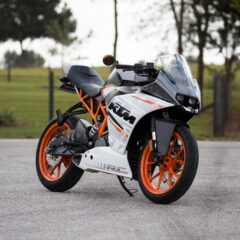
7 Top Motorcycle Accessories
With Christmas just around the corner, you might be wondering what to get your favourite motorcycle enthusiast or even a little something for yoursel...
 Phoenix Motorcycle Training LTD
Phoenix Motorcycle Training LTD
 Phoenix Motorcycle Training LTD
Phoenix Motorcycle Training LTD

Riding a motorcycle has become much safer with each passing generation. In the early 80s, around 20,000 motorcyclists were killed or seriously injured each year on UK roads. Most recent figures show that’s dropped to less than 6,000 riders. That’s thanks to a combination of changing road rules, better training and licensing regulations, and advances with motorcycle safety technology.
Even so, motorcyclists are some of the most vulnerable road users. Rural roads are a higher risk to riders than urban roads or motorways. Remembering your rider routines, staying visible and learning to ride defensively will improve your safety on the road—rural or otherwise. Of course, better motorcycle safety technologies will reduce your risk of serious injury too.
We’ve come a long way since the invention of indicator lights and rear view mirrors were added to motorcycles. These days, ABS braking, traction and stability controls, and smart technology are making riding less risky without reducing the fun factor. Motorcycle gear has come a long way too with smart helmets and inflatable jackets cushioning any unfortunate falls. Read on to see how these motorcycle safety technologies will improve your ride.
Just like the name suggests, anti-lock braking systems (ABS) stop your wheels from locking when you hit the anchors. That gives you more control for emergency stops. It reduces your risk of skidding and shortens your stopping distance.
ABS works with sensors, a control unit, and hydraulics. The sensors count the revolutions of your wheel when you brake. When that dramatically decreases, it sends a signal to the control unit. That triggers the hydraulic valves to be activated, allowing the wheel to continue spinning.
One of the great things about ABS is that it only becomes active when you need it. One study showed a 22% reduction in fatal crashes. That’s thanks to the shorter stopping distances, improved rider stability and better control in the emergency stopping situation.
But ABS isn’t a cure all. It won’t make a huge difference to your stopping distance on dry roads and aggressive braking is still risky. You’ll still need to maintain safe distances from traffic around you and stick to speed limits.
This motorcycle safety technology is ideal for riding in poor conditions like heavy rain, ice and snow. But it should be left on in all conditions because it prevents drifting, wheelies and skidding — all situations that rob you of control and reduce your acceleration abilities.
This technology relies on sensors, just like ABS does. These sensors monitor the speed and rotation of your front and rear wheels and compare that with the angle of your motorcycle and the position of your throttle. When a loss of traction is detected, it decreases power to your back wheel to improve balance and stop uncontrollable wheel spins.
That’s not to say that traction control will make it more difficult to steer or take corners at pace. You’ll still be able to lean into corners fast, just with more confidence and better responses from your machine to the road conditions.
KTM’s traction control video shows how their system works in action. Their system comes with different levels of MTC; Sport, Street, Rain and Off-Road. All with varying levels of intervention for rear wheel spinning. Other motorcycle makes have similar variations for traction control.
Once again, it’s sensors at work behind motorcycle stability control (MSC). This safety technology monitors the rotations of your front and rear wheels, and uses a gyroscope to register the angle of your motorcycle. Depending on the situation, it adjusts the power of your engine, engages your brakes, or both, to prevent slides and low-side crashes.
MSC is ideal for providing additional stability for cornering in slippery conditions. It can stop your wheels from locking, slipping on curves, and stop your motorcycle from standing up when braking in a curve. Traction control and ABS are more common in motorcycles than stability control. However, this safety technology became mandatory for European cars in 2014, so may become more common in motorcycles with time.
It seems like everything is getting smart these days – T.Vs, toasters, fridges and cars. Helmets aren’t immune to smart tech either. Smart helmets come in varying levels of smartness. We’d argue that some of the features—like music playback—maybe aren’t so smart because you need your ears and mind on the road around you to stay safe. That said, there are some pretty cool safety features for modern smart helmets.
Features like moisture wicking fabrics, anti-fog films and EPS foam improve comfort and safety. Smart phone pairing technology makes GPS directions simpler for riders. Other smart technology, like the MIPS protection system can redirect impact forces away from the head to reduce the risk of brain injury.
When choosing a helmet, safety should be your top priority. Check SHARP ratings and make sure you choose something that fits properly. When it comes to smart enhancements, it depends on your riding style, the smart technology you’re choosing, and how much that improves your convenience and safety whether it’s worth the additional investment. Our advice would be to pay more for the highest sharp rating you can afford rather than compromising that for tech.
A lot of the safety technology car drivers are familiar with is making its way to motorcycles too. Adaptive cruise control, blind spot censoring, and lane departure warnings are being integrated into motorcycles already. Air bag technologies have found their way into motorcycle jackets and augmented reality head up displays are being integrated into helmets.
Some riders will find these helpful and reduce their risk on the road. Others may find it distracting (we’re looking at you, helmets with phone call connectivity!) or that it somehow robs them of the feel and control of their machines. While some safety features are definite plusses for riders across the board, others will be influenced by riders’ preferences and styles.
Motorcycle safety technology is an area that will continue advancing. Further research and development is inevitable. It’s also necessary if we want to reduce our vulnerability on the road without detracting from the fun, freedom, and adventure motorcycling offers. So it’s worth your time staying up to date with advancements in this area.
Even so, with the best will in the world, motorcycle safety technology will never replace the need for rider skill, attention to the road, and a willingness to keep practicing manoeuvres and techniques. Improving your roadcraft will always be important for riding safely and confidently. So keep your eyes on the road, your thighs and feet anchored to your bike, and enjoy a safe and exhilarating journey with the right motorcycle safety technology for your ride.

With Christmas just around the corner, you might be wondering what to get your favourite motorcycle enthusiast or even a little something for yoursel...

If you love motorcycle riding, you’ve probably daydreamed about riding a motorbike for a living. A professional racer or stunt rider is OK for some...

Getting a UK motorcycle licence can seem a complicated process. Particularly when compared to a driving licence for a car. Whether you choose the pro...
This website uses cookies to personalise content, ads, and analyse traffic, sharing data with partners who may combine it with other information. See our Privacy Policy for more information.